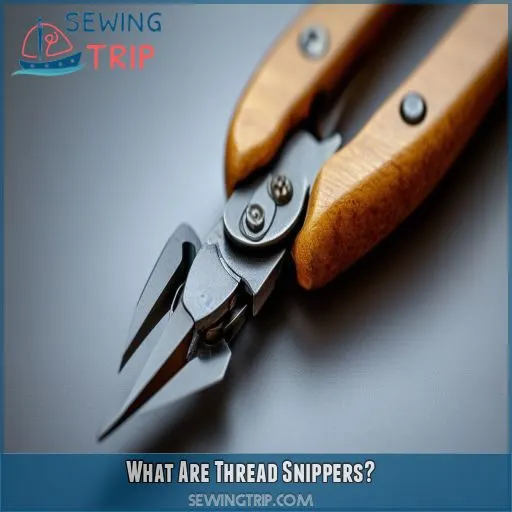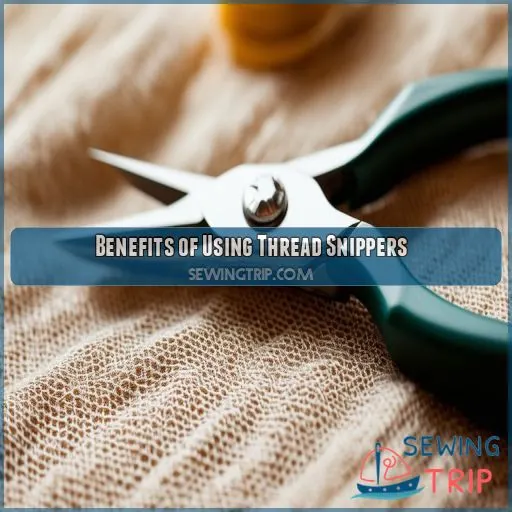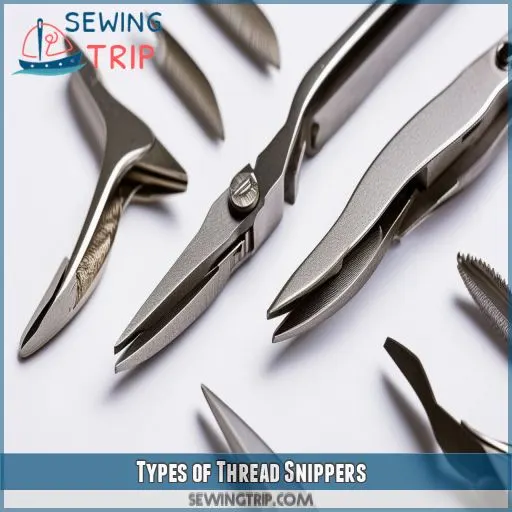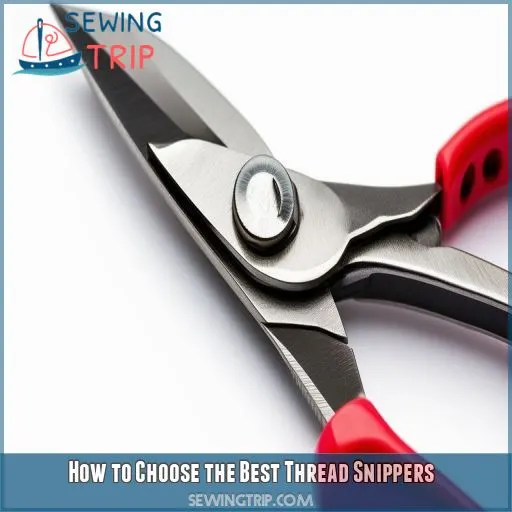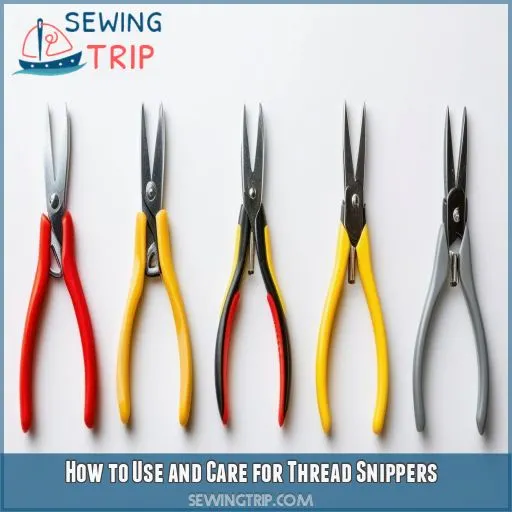This site is supported by our readers. We may earn a commission, at no cost to you, if you purchase through links.
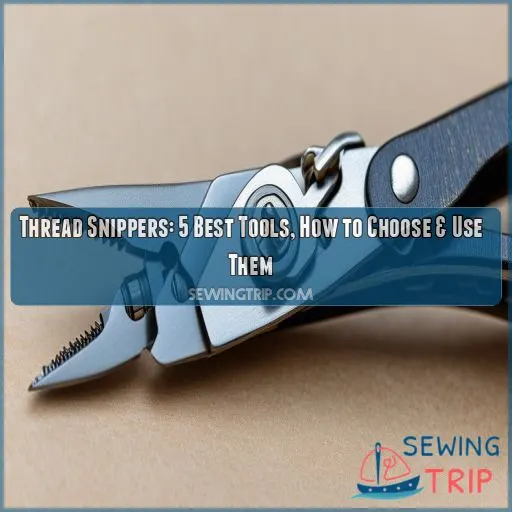
If you want to learn more about thread snippers, we’ve got a lot to share.
Table Of Contents
Key Takeaways
- Thread snippers are small but mighty tools designed for comfort, efficiency, and versatility, allowing you to cut threads and fabric with precision.
- They come in various types, including straight, curved, serrated, spring-loaded, and locking, each catering to specific needs like reaching tight spots or cutting delicate fabrics.
- These snippers are a must-have for any sewing enthusiast, saving your regular scissors from wear and tear and providing quick, precise cuts.
- With sharp blades, comfortable grips, and lightweight designs, thread snippers enhance your crafting experience, offering speed and precision for a range of projects.
What Are Thread Snippers?
Thread snippers are small tools that pack a punch in the sewing world. They’re like tiny scissors, helping you quickly and precisely cut threads and fabric with ease.
A Small but Mighty Tool for Sewing
You’ve heard the saying, "Good things come in small packages."
Well, thread snippers are the epitome of that!
These tiny tools pack a powerful punch in the sewing world.
They’re your secret weapon for snipping threads with precision and ease.
Say goodbye to the tedious task of trimming those tiny thread ends with regular scissors.
Thread snippers are designed to be comfortable, efficient, and versatile, making them a must-have addition to your sewing kit.
Used for Cutting Threads and Fabric
Thread snippers are a small but essential tool for any sewing enthusiast. They’re used to cut threads and fabric with precision and ease. Whether you’re a quilting queen or an embroidery enthusiast, thread snippers offer a quick and efficient way to trim threads and fabric, leaving your projects with a clean and professional finish.
Comfortable to Use and Easy to Handle
N/A
Benefits of Using Thread Snippers
If you’re wondering why you should bother with thread snippers, get ready for some serious perks. These handy tools speed up your sewing and stitching, giving you precise cuts without damaging your scissors.
Let’s look at the benefits and see why thread snippers are a must-have for any sewing enthusiast.
Prevents Blunt Spots on Scissors
Using thread snippers saves your regular scissors from the wear and tear of constantly cutting small threads. The precise cutting edge of thread snippers means you can quickly trim threads without worrying about blunting your scissors’ blades.
Makes Sewing and Stitching Faster
Thread snippers are a game-changer for sewing efficiency. Here’s how they make your stitching speedier:
- Quick Trims: With a snipper, you can swiftly trim threads without pausing your sewing flow.
- Continuous Sewing: No more interruptions to search for scissors or fumble with tiny thread ends.
- Time-saver: The spring-loaded mechanism speeds up the cutting process, so you spend less time trimming and more time stitching.
Provides Precision Thread Cuts
Say goodbye to those frustrating moments when your scissors just won’t cut it (pun intended).
Thread snippers are designed to deliver precision cuts, leaving minimal thread ends in their wake.
This means you can focus on the task at hand without worrying about those pesky little threads getting in the way.
With their sharp blades, thread snippers make sure that your cuts are clean and accurate, giving your projects a professional finish.
Versatile Tool for Various Crafts
Thread snippers are a versatile addition to your crafting toolkit. They’re not just for sewing enthusiasts – these snippers are a handy tool for a range of crafts. Here’s why:
- Bead Weaving: Snippers are ideal for trimming threads in tight spaces, making them a go-to tool for bead weavers.
- Leather Work: Crafters working with leather will find thread snippers useful for quick, precise cuts without damaging the material.
- Knitting & Crochet: Yarn crafters can use snippers to neatly trim yarn ends, adding a professional finish to their creations.
- Embroidery: For embroiderers, thread snippers provide a comfortable way to cut threads without the risk of damaging delicate fabrics.
- Multi-Crafting: Thread snippers are a versatile essential for multi-crafters, offering precision and speed for a range of projects.
Types of Thread Snippers
There’s a whole range of thread snippers out there, each with unique features. From straight and curved blades to serrated and spring-loaded options, you’re sure to find the perfect snipper for your sewing needs.
Let’s take a closer look at the different types of thread snippers available and how they can enhance your crafting experience.
Straight Blade Thread Snippers
Straight blade thread snippers are a must-have for tackling thick fabrics and trimming threads close to the fabric’s surface. Their sharp, straight blades cut through dense materials with ease, making them a powerful tool in your sewing arsenal. With straight blade thread snippers, you can effortlessly trim threads without the hassle of awkward angles.
Some users rave about the ease of use and sharpness of Singer’s straight blade thread snippers, giving them top ratings for their ergonomic handles and cutting performance.
Curved Blade Thread Snippers
Curved blade thread snippers are ideal for reaching tricky spots. Their bent blades allow for precise placement, making it easier to cut threads close to the fabric without catching other threads or materials. You won’t have to twist your hands into awkward angles with these snippers.
Serrated Blade Thread Snippers
Serrated blade thread snippers are designed for cutting delicate fabrics and trimming threads in tight spaces. Their unique serrated blades offer several benefits:
- Longevity: The serrations prevent slipping and fraying on finer threads, extending the life of the cutting blade.
- Safety: The serrated blade helps to prevent accidental cuts, giving you more control over your cuts.
- Smooth Performance: These blades deliver smooth, long-lasting performance, ensuring your thread snippers glide through projects with ease.
Spring-Loaded Thread Snippers
Spring-loaded thread snippers are a type of thread snipper that offers a quick and easy way to cut threads with minimal effort. They’re compact, lightweight, and often spring-loaded for ease of use. This type of thread snipper is ideal for those who want a comfortable and efficient cutting experience.
Locking Thread Snippers
Locking thread snippers are a type of thread snipper that features a locking mechanism to prevent accidental cuts. This design makes them a safe option, especially when you’re snipping threads in tight spaces or working with delicate fabrics.
Key Features of Locking Thread Snippers:
- Locking Mechanism: Keeps the blades closed when not in use, preventing unintended cuts.
- Safety: Reduces the risk of injury, making them ideal for beginners or when working with kids.
- Control: The locking feature gives you added control over your cuts, allowing for precise and deliberate snips.
- Portability: Their compact design and locking mechanism make them convenient for on-the-go projects.
- Versatility: Locking thread snippers can handle various fabrics, from delicate silks to thicker materials.
How to Choose the Best Thread Snippers
When choosing the best thread snippers, there are a few key things to keep in mind: brand reputation, blade material, handle comfort, weight, grip, and price. Go for reputable brands, stainless steel blades, and comfy handles.
Consider Reputable Brands
When you’re looking for thread snippers, brand reputation is important. Big brands like SINGER, Gingher, and Fiskars are known for maintaining a certain quality standard to keep their customers happy.
SINGER, for example, is dedicated to helping people express their creativity through sewing with high-quality equipment and accessories. Their thread snippers are individually inspected and hand-tested, making sure they’re precise and durable.
Look for Stainless Steel Blades and Comfortable Handles
When choosing thread snippers, it’s important to look for quality blades and handles that will make your crafting experience a breeze. Here are some key considerations:
- Stainless Steel Blades: Go for stainless steel blades as they’re durable, corrosion-resistant, and hold their sharpness longer. This means you’ll get clean, precise cuts through various threads and fabrics.
- Sharp vs. Blunt Tip: Choose sharp-tipped thread snips for detailed work and precise cutting. Opt for blunt-tipped ones for heavier materials and projects where safety is a priority.
- Comfortable Handles: Look for handles with a comfortable grip. Rubber or plastic overlays provide a secure grip and reduce hand fatigue during extended crafting sessions.
Check the Weight and Grip of the Snippers
The weight and grip of thread snippers are important factors to keep in mind when choosing the best tool for your needs. You want something that feels comfortable in your hand and allows for precise cuts.
If you have arthritis or hand pain, opt for lightweight snippers. These will reduce strain on your hands and wrists, making it easier to sew for longer periods without discomfort.
For quick trims, choose thread snippers with a comfortable grip. This will help your hand from tiring easily, and you can snip threads with minimal effort.
Price and Quality of the Snippers
You can find thread snippers at various price points, from under $10 to over $100. The price often reflects the quality, but you don’t have to break the bank to get a good pair. Here are some tips to help you choose:
- Budget-friendly options: You can find great embroidery scissors for most sewing needs for under $10. Amazon offers a range of affordable options, including lightweight thread clippers with colorful designs.
- Upgraded snips: If you’re looking for something more durable, stainless steel options are available, along with unique designs like duckbill and heart-shaped scissors, typically ranging from $15 to $30.
- Ergonomic snips: For added comfort, consider spring-loaded blades and curved blades to reduce wrist strain. Padded handles and a lightweight design can also enhance your comfort and control.
- Decorative snips: Stork embroidery scissors, vintage-inspired designs, and antique scissors offer a touch of charm to your sewing space.
- Quality and durability: While you can find functional thread snippers at lower price points, investing in a higher-quality pair can offer improved durability and sharpness.
Top 5 Thread Snippers for Sewing
Whether you’re a sewing novice or a quilting queen, having the right tools can make all the difference. We’ve rounded up the top 5 thread snippers on the market to help you decide which one is worth your hard-earned cash.
1. Gingher Thread Nippers Fabric Scissors
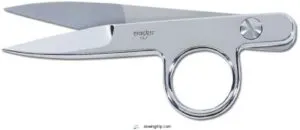
If you’re after a basic necessity for sewing and needlework, the Gingher Thread Nippers Fabric Scissors are a solid choice. They’re carefully crafted with thick, precision-ground blades that can snip through threads, trim seams, and cut heavier yarns and thick fabrics with ease. The standout feature is the double-plated chrome-over-nickel blade finish, which adds durability, but it also looks striking. The single-loop handle design might take some getting used to, but it provides increased stability and a comfortable grip. Just be sure to store these safely – the blades are sharp!
Best For: Sewing and needlework enthusiasts who need a reliable tool for snipping threads, trimming seams, and cutting heavier yarns and fabrics.
- Meticulously crafted with thick, precision-ground blades for durability and precision.
- Double-plated chrome-over-nickel blade finish adds both durability and a striking look.
- Specialized single-loop handle design provides stability and a comfortable grip.
- Some users find the single-loop handle design awkward.
- The protective nylon sheath is small and easily lost.
- The blades are sharp and require careful storage.
2. Fiskars Premier Thread Snips

These snips are a great choice for precise cutting. They feature razor-sharp, premium-grade stainless steel blades that can cut through fabric, thread, ribbon, and more with ease. The pointed tips give you unmatched control when trimming in tight spaces. The built-in blade guard and orange dot on the scissors enhance safety during storage and travel. Users praise the sharpness and ease of use, making these snips a top choice for quality and functionality.
Best For: These snips are perfect for crafters, sewers, and anyone who needs a small, sharp pair of scissors for precise cutting.
- Razor-sharp, premium-grade stainless steel blades for effortless cutting.
- Pointed tips provide exceptional control for trimming in tight spaces.
- Built-in blade guard ensures safe storage and travel.
- Some users report blade catching, particularly at the tip.
- It’s unclear if the blades can be sharpened.
- The size and weight may not be ideal for everyone.
3. Singer ProSeries Thread Snips 5 Inch

The Singer ProSeries Thread Snips offer precision thread snipping with their sharp blades. The TPR comfort grip handles, along with the spring action, make these snips easy to use. They’re durable, reliable, and versatile, handling threads, yarns, ribbons, and embroidery floss with ease. Weighing only 1.44 ounces, these snips are lightweight and maneuverable. However, some users have reported issues with the snips staying closed after use, so keep that in mind.
Best For: Crafters and sewers who need precise thread snipping for projects.
- Sharp blades for precise cutting.
- Comfortable TPR grip handles.
- Lightweight and maneuverable.
- Some users reported issues with the snips staying closed after use.
- Not recommended for general cutting tasks.
- Made in China.
4. Stainless Steel Wire Cutters with Cord
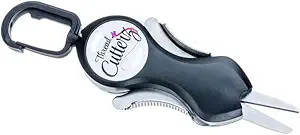
This lightweight option (1.4 ounces) is a versatile tool for cutting thread, yarn, and embroidery floss. The 36-inch retractable cord and clip make it easy to grab and use. Safety is a priority with the blade locking feature, and serrated cutting blades provide smooth, long-lasting performance. These wire cutters are ideal for quilting, with positive reviews highlighting their effectiveness in cutting corners on half-square triangles. However, some users have expressed concerns about durability and quality.
Best For: Crafters, quilters, and anyone who needs a lightweight, versatile tool for cutting thread, yarn, and embroidery floss.
- Lightweight and easy to use.
- Retractable cord and clip for convenient access.
- Blade locking feature for safety.
- Some users have reported durability issues.
- Cord sticking issues have been reported.
- Quality concerns have been expressed by some users.
5. Thread Cutterz Sewing Scissors
These snippers are a handy, versatile tool for crafters. They feature a two-sided stainless steel blade that cuts through various materials, from yarn to embroidery floss. You can adjust the strap to fit any finger size, and the lightweight design makes it easy to mount anywhere. While it’s a solid choice, some users report discomfort, and it may not be suitable for heavy-duty use.
Best For: Crafters who need a convenient and versatile tool for cutting yarn, thread, and embroidery floss.
- Two-sided stainless steel blade cuts through various materials.
- Adjustable strap fits all finger sizes.
- Lightweight design makes it easy to mount anywhere.
- May not be as comfortable as some users would like.
- Can be chewed by pets.
- May break with heavy use.
How to Use and Care for Thread Snippers
Now that you’ve chosen the perfect thread snippers, it’s time to master the art of using and caring for them. This section will guide you through the process, ensuring your new tool stays in tip-top shape and serves you well for years to come.
How to Hold and Use Thread Snips
Holding and using thread snips is easy, but it’s important to get your grip right to avoid hand fatigue. Here’s a simple technique to follow:
- Place your thumb on top and your other fingers supporting the bottom of the thread snips.
- If your thread snips have a finger loop, wear it on your ring finger, with your thumb placed on top.
- Push your thumb down to close the blades and make a cut.
Thread snips are small, spring-loaded scissors that hang from your finger, ready to trim loose threads as you finish a garment or seam. They’re a handy tool to have close at hand when crafting or sewing.
How to Sharpen Thread Snips
Sharpening your thread snips is essential for maintaining their precision and performance. Here’s a step-by-step guide:
- If your thread snips can be separated, keep the edge flat on a whetstone (- If your snips can’t be separated, open them as wide as possible and use a small handheld rod.
- For a touch-up, use a high-grit diamond rod to clean the heel and tip of the edge.
- Finish by deburring on leather, cardboard, or newspaper to remove any remaining burrs without damaging the backside of the blade.
Cleaning and Storing Thread Snippers
Cleaning and storing your thread snippers properly is key to keeping them in tip-top shape. After each use, give ’em a quick wipe with a clean cloth to prevent any gunk from building up. You don’t want crunchy blades, do ya?
For storage, a scissors holder or a lightweight pouch will do the trick. Keep ’em safe and sound, away from the dangers of being dropped or lost. You could even get a vintage scissors holder to add a touch of charm to your sewing space.
Tips for Maintaining Thread Snipper Performance
Keeping your thread snippers in tip-top shape is key to getting those smooth, precise cuts. Here are some tips to help you out:
- Sharpness: Keep those blades sharp. Dull blades lead to uneven cuts and can even damage your fabric. Sharpen your snippers regularly with a sharpening stone or by cutting through foil.
- Cleaning: Wipe the blades after every use to stop thread buildup and keep those blades moving smoothly.
- Storage: Store your snippers in a safe place, like a designated pouch or compartment in your sewing kit, to avoid losing them or accidentally bending the blades.
- Lubrication: Apply a small amount of machine oil to the blades every so often to keep them cutting smoothly and effortlessly.
Thread Snipper Maintenance and Troubleshooting
Now that you’re a thread-snipping pro, let’s keep your snippers in tip-top shape. We’ll cover sharpening, troubleshooting common issues, preventing damage, and knowing when to replace your trusty tool.
How to Sharpen a Thread Snipper or Sewing Snip
Sharpening your thread snippers is a delicate task, but it’s doable. You can use a whetstone or a small ceramic rod. If you’re using a whetstone, focus on one side, and don’t worry about the bottom 20% of the blade. If you’re unhinging your snippers, use a small handheld rod. Just make sure not to sharpen the back side.
Common Issues With Thread Snippers and Solutions
You might face issues with your thread snippers over time. Here are some common problems and quick fixes:
- Blade issues: If your blades become blunt or misaligned, try sharpening them using foil or a sharpening stone.
- Spring action: When the spring loses tension, it can be replaced or adjusted.
- Handle comfort: If the handles become uncomfortable, try adding rubber grips or purchasing ergonomic snippers.
How to Prevent Thread Snipper Damage
You can keep your thread snippers in tip-top shape by wiping the blades with a clean cloth after each use. This prevents the blades from crunching when you cut. Avoid dropping your snippers, and only use them on thread or cord. To sharpen, cut through multiple layers of foil.
When to Replace Your Thread Snippers
It’s time to replace your thread snippers when:
- The blades get dull and don’t cut threads effectively anymore.
- They’re damaged or broken, like when they fold threads between the blades instead of cutting them.
- You’ve used them for tasks other than cutting threads, which can dull the blades or damage the snippers.
- You find a higher-quality pair that better suits your needs, like those with sharper blades or a more comfortable grip.
Frequently Asked Questions (FAQs)
What are the characteristics of thread snips?
Crafters, listen up! Thread snips are compact, lightweight, and spring-loaded for quick, precise cuts. They’re perfect for sewers and yarn crafters who need to snip threads, notch fabric, or clip yarn ends.
What are the characteristics of threading?
Threading has a range of characteristics depending on its type and intended use. There’s spun thread, filament thread, monofilament thread, bonded thread, corespun thread, textured thread, and glazed thread, each with unique properties.
What are the characteristics of needle threader?
Needle threaders are simple, inexpensive devices that help you pass thread through a needle’s eye. They’re usually made of wire, shaped like a diamond, and attached to a coin-shaped handle.
What are the characterization of sewing threads?
Sewing threads come in a variety of materials, from cotton to nylon. They should have good tensile strength, uniform thickness, and good elasticity for a smooth stitch. Also, look for good colour fastness to avoid fading and metamerism.
How often should I sharpen my thread snippers?
You should sharpen your thread snippers when you notice they’re not cutting as well as they used to. Some thread snippers stay sharp for a long time. If you don’t want to sharpen them, you can buy a new pair every few months.
What are the best thread snippers for beginners?
If you’re new to sewing, try the Kretzer ECO 5" Thread Snips. They’re sharp, durable, and corrosion-resistant. Or, for a mini, multi-functional option, the Le Qian Shangmao 3Pcs Sewing Scissors Clippers are a great choice.
How do I use thread snippers safely?
To use thread snippers safely, keep them away from kids and pets, and only use them for cutting thread or cord. Avoid overusing them and always store them in a safe place.
Can I use thread snippers on yarn?
Yes, you can use thread snippers on yarn. They’re versatile tools that can cut through various materials, including thread, yarn, and fabric. Just make sure you don’t overuse them on anything that’s not thread or cord.
Whats the difference between thread snippers and regular scissors?
Thread snippers are flat on the bottom, making it easier to get close to the fabric without damaging it. They’re also spring-loaded, so you can just grab and snip without looping your fingers through.
Conclusion
Well, stitch in time, my friend! Now that you’re well-versed in thread snippers‘ characteristics, from their tiny scissor-like design to the various blade types, you’re ready to snip with precision. Remember, choosing the right snippers and keeping them in good shape will make your crafting projects stand out. So, keep these tips in mind, and happy crafting!

